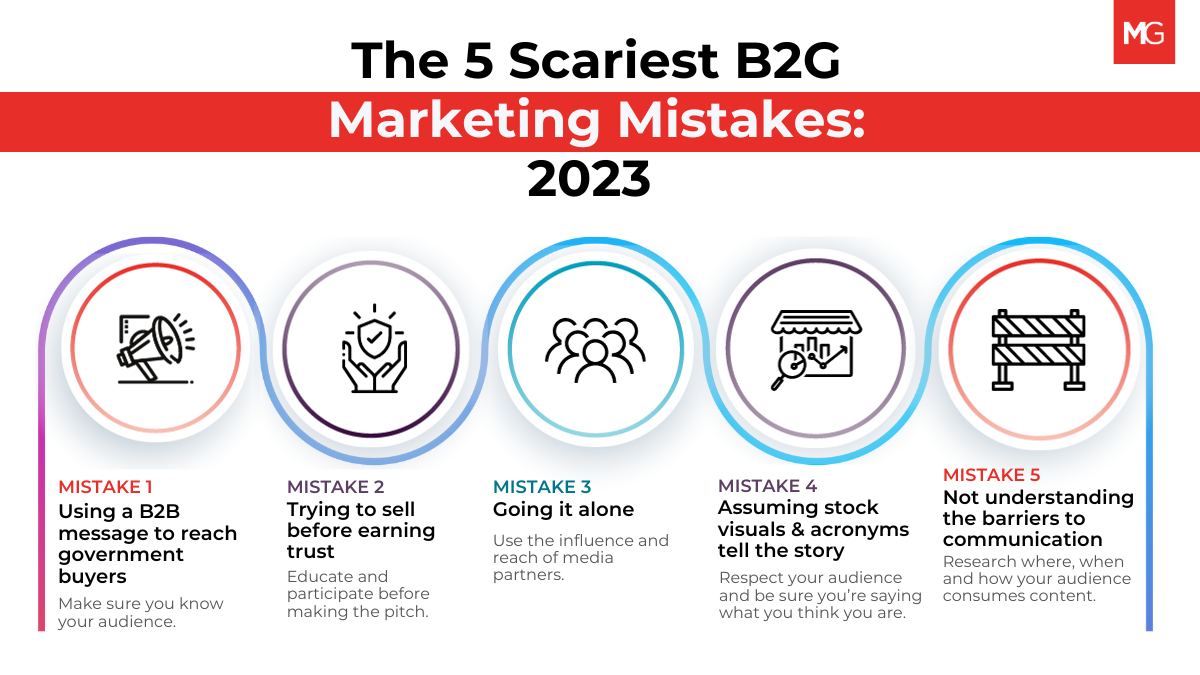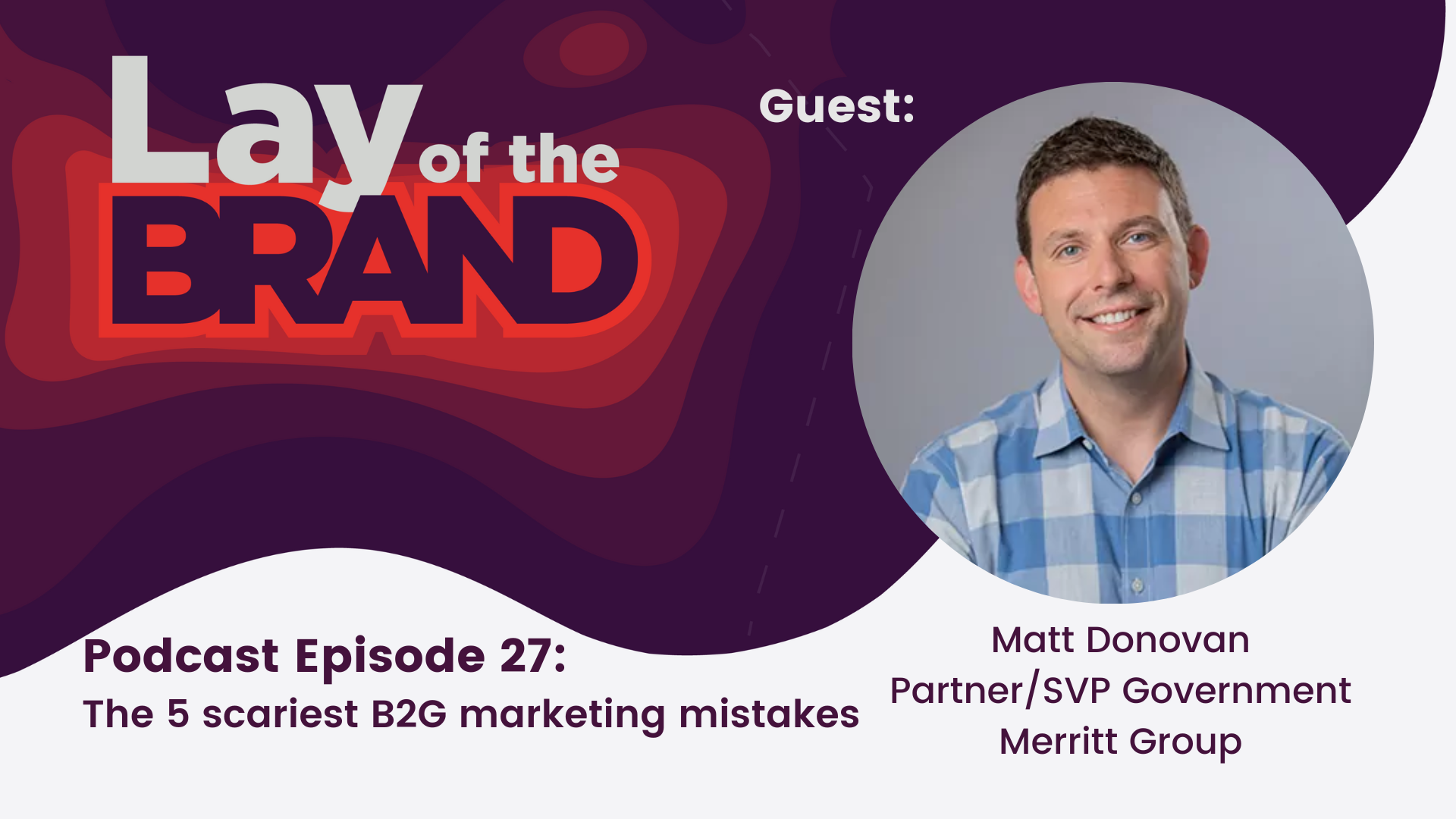In the spirit of spooky season, we’re looking at the 5 scariest mistakes B2G marketers make. A lot of government-focused companies have strategies in place to crack this code, and have even engaged marketing and PR agencies to help them do it right. Even so, it’s too easy to make avoidable errors that can derail your program — and your ability to engage government buyers.
To find out how to avoid these errors, we’re talking with Matt Donovan, a Merritt Group partner who leads the government marketing and PR team.
A shocking amount of marketing does not include empathy. It is shouting from the mountain tops about how amazing your company is and what your product can do. And I really think great messaging starts with understanding the customer challenge, what are they dealing with
— Matt Donovan, Partner, Merritt Group
About out guest: Matt Donovan leads the agency’s Government practice, where he creates strategic content marketing and communications campaigns that reach technology decision makers and build trust and confidence in bold new solutions.

For more great insights, download the Merritt Group B2G Marketing Playbook
Episode transcript (edited for clarity)
Peter Jacobs, Lay of the Brand: Those of us marketing to the government know that it’s very different from a B2B approach — how and where you reach those buyers and influencers, how you tell your story, the sales cycle itself, and what matters most to that audience is its own unique world. A lot of government-focused companies have strategies in place to crack this code, and have even engaged marketing and PR agencies to help them do it right. Even so, it’s too easy to make avoidable errors that can derail your program — and your ability to engage government buyers.
To find out how to avoid 5 of the biggest mistakes that government marketers and their agencies can make, we’re talking with Matt Donovan, a Merritt Group partner who leads the team focused on government marketing and PR. Thanks for being here, Matt.
Matt Donovan, Merritt Group: Thank you, Peter.
Peter Jacobs, Lay of the Brand: All right, let’s just dive right in. What are the five most avoidable mistakes government marketers make? Let’s tackle them one at a time.
The first one is using a generic B2B message to reach government buyers. That’s assuming that the same metrics and benefits that work for commercial customers resonate with government decision makers. Probably not a recipe for success is it?
Matt Donovan, Merritt Group: It is not. It’s Halloween season and these mistakes are terrifying. They are absolutely disastrous. So, yeah, the first one, kind of taking a generic B2B message. We’ve seen this in the past and it reminds me of an event that I attended a few years ago.
It was a FedScoop FedTalks event, and a global tech leader was sort of introducing themselves to the federal IT market. This was their first big investment and they essentially walked through their generic B to B sales deck in front of an audience of federal decision makers, federal buyers, potential partners.
And the reaction was not just people looking at their phones but literally getting up and walking out of the session. And the result wasn’t just a miss on an enormous investment. We know those event investments, those sponsorships that come with thought leadership, those come with big, big dollar tags.
And not only was it a miss, it actually alienated the market because this gentleman who was just trying to introduce his company to the market was talking about driving revenue and things that just are not what agencies are trying to do.
So that was the first time that it really hit home for me where it’s like, wow, people think they can just take their B to B message here. And it is not something that works.
Peter Jacobs, Lay of the Brand: That’s frightening on a lot of levels that, first off, that somebody came into something that they knew was government focused and said, yeah, it’s the same thing. But also you think about the long tail of that, that now when anybody who was in that room thinks of that company, they’ll think “those people don’t know me.”
Matt Donovan, Merritt Group: Totally. It’s not just, oh, I’m not sure what they do. I’m not sure they can help me in this market. It’s “they don’t get it.” It’s a negative brand perception right out of the gate. So those are the stakes that we’re really talking about.
Peter Jacobs, Lay of the Brand: And there is kind of a sense that, well, people will be able to figure out our value if we just explain what it is we do. How do you advise a company that wants to federalize its message? How do you get them to change their perspective?
Matt Donovan, Merritt Group: Well, you and I have talked about this for years and I know we both talk about good marketing requires empathy, which is the ability to put yourself in the shoes of who you’re talking to.
And a shocking amount of marketing does not include empathy. It is shouting from the mountain tops about how amazing your company is and what your product can do. And I really think great B2B messaging, federalizing messaging starts with, you know, understanding the customer challenge, what are they dealing with: What are their pain points? What are they trying to accomplish? How are they being measured day to day? How does what you can give to them align to their agency, strategic priorities and goals?
If you can show you understand that context and you understand what they’re trying to do, that’s the foundation of federal messaging and quite honestly any vertical messaging.
But especially in B2G, you have to have that knowledge of, you know, the customer pain point, what you can deliver for them.
Peter Jacobs, Lay of the Brand: Yeah, when you think about it, it’s not just, hey, this is how government agencies do things, you know, accomplish their jobs differently than commercial companies. It’s how they buy things.
And if you don’t understand that cycle and who’s involved and what the acquisition process is, it doesn’t matter what a whiz bang thing you have, it won’t make a difference because you’re not going to get their attention, you’re not going to get them to see that you really do understand them.
Matt Donovan, Merritt Group: Absolutely.
Peter Jacobs, Lay of the Brand: It occurred to me just a little while ago. That part of the problem may be a mixed message from the government side where they say, “we really want this commercial innovation happening here inside our agencies,” but that’s different from being pitched in a B2B way.
Matt Donovan, Merritt Group: And, a lot of times, a lot of these buyers and agencies don’t know what they don’t know, which is why education is so important. It’s like they want to modernize and they know they need to, you know, embrace digital tools, but it is on industry to talk about how these things can be implemented realistically within the context of the mission.
I think a lot of times it’s on industry to show the path where it’s like this is possible and this is how it can help you, and this is how you start, these are the phases in the process.
So I think laying out that picture is incredibly important and is foundational to any good B2G marketing.
Peter Jacobs, Lay of the Brand: And that kind of leads us to “the most avoidable mistake” number two, which is trying to sell before earning trust. If you’re not matching what you’re saying to where they are in the sales cycle, you’re just too far ahead of your audience.
Do you find that too often, government focused companies will jump to the pitch a little too soon?
Matt Donovan, Merritt Group: Absolutely. This might be the scariest one for me. You talked about the B2G procurement cycle and the sales cycle—we know B2G sales cycles are much longer and much more complicated than B2B, when you’re talking about a 12, 18, 24 months multimillion dollar procurement on an enterprise-wide technology solution.
That’s a long sales process that requires a lot of checks and balances. And if you’re trying to jump the gun and get to the heavy sales pitch before these decision makers even know who you are, what you do, why they should care if you’re committed to this market, if you know anything about them or their mission.
It’s not only not gonna resonate, it’s going to be a turn off. You know, I think of other types of relationships in life. This is proposing on the first date.
It’s like you need a lot more information to make a good decision. I’m not even gonna entertain that question until we get a little bit more time with each other. I have seen B2B brands just jump into the market like a bull in a China shop and immediately want, “how do I gather leads?” “How do I accelerate the procurement cycle?”
And yet you really have to build a foundation before you get into that hard sales pitch. And there’s data that backs this up.
You know, we love the Market Connections folks over at GovExec and their M4 PS study is really clear about different types of content at different phases of the cycle and early on you have to prove that you understand the challenge. You understand the agency’s vision, you understand the market before they’re even open to talking about your product, your solution, why you might be different than your competitors.
Peter Jacobs, Lay of the Brand: Trust is something that gets developed over time. Besides rushing it, you have to establish yourself as somebody to be trusted. That’s not easy because just like in the B2B world, people are going to make decisions by first checking with their, their colleagues, their friends, people, they already know and have good relationships with and have had the kinds of conversations where coming out of that they can say, OK, that person knows what they’re talking about and it does apply to my world. And that gives me a direction
You start out as a vendor or already in, I won’t say adversarial but already in a situation where the person on the other side of the desk is saying, “what does this person want to sell me?”
So let’s talk about how you become a trusted authority. How do you become somebody who the potential customer can feel confident in?
Matt Donovan, Merritt Group: It does absolutely take time, to your point. Like any relationship, it does go back to that messaging, which is, “talk to me in a way where it’s clear, you know, that you can help me do my job better or you can impact what I’m trying to accomplish.”
So it’s time, it is education. It’s bringing them information that’s useful and valuable and relevant over a long period of time and building that relationship.
This reminds me of another example where we were working with a major 5G telecom player and they were really standing up a campaign for DoD, they were targeting DoD decision makers. We were doing a lot of the marketing strategy. We were working with a B to B firm that was doing a lot of the social.
This B to B firm had had a lot of success DMing decision makers on the B2B side over platforms like Twitter and LinkedIn. So their idea in B2G was, hey, we’re, we’re trying to sell into the top levels of leadership. We’re gonna start DMing three and four star generals on social media platforms.
And we were like, whoa, whoa, whoa, whoa, whoa, whoa, whoa, whoa, let’s slow down, let’s slow down a little bit. Let’s think about this. So that’s obviously an exaggerated example.
But my goodness, imagine starting there before you’ve established your brand before you’ve established credibility, you’ve established any rapport with the ultimate decision maker that you’re gonna just kick off the relationship with a cold DM.
Our guard is initially up in those things. We’re like, “oh, OK, more spam.” And then the other thing which is becoming a theme of this conversation that I didn’t even realize is, it’s a bad first impression.
Again, it’s not just something that doesn’t work, it’s leaving your target audience with a negative brand perception of you just because of this activity that doesn’t take into account the nuance of the relationship building process or how the government buys technology in the first place.
Peter Jacobs, Lay of the Brand: And those first impressions last, someone’s always gonna remember. You’re the one who emailed me, you know, all these sales slicks and I’m not the person who reads those anyway. So what should somebody be doing if you’re trying to become that trusted authority. You mentioned content earlier. How does that play into it?
Matt Donovan, Merritt Group: Content from the perspective of the customer has the customer in mind, the customer pain points. The other thing that I wanted to say is to get there to get at that customer intimacy.
It really involves working with the folks in your organization that are on the front lines, who are talking to these customers, who know these customers. It’s typically the sales and BD team, the capture teams. They’ve got intimate knowledge of the decision makers, what the agency is trying to do. Hopefully, hopefully they do.
It is shocking to us how often BD marketing and public relations or earned media are not on the same page. They’re sort of in silos doing their own thing. And it’s obviously critical when, maybe you’re collectively positioning for an opportunity, like a big, upcoming contract—getting with BD, having BD and marketing on the same page aligning on win themes: “How are we different?” “What are they trying to accomplish?”
That is absolutely critical, but just as in all marketing, right, being in sync with the entire external-facing organization on the strategy, on the message—that is absolutely essential and it’s just easier said than done.
You know, we’ve all been talking about how sales and marketing have to get on the same page for 20 years. But honestly, we can, we can still do a lot better and we can still do a lot better in, in B to G.
Peter Jacobs, Lay of the Brand: Well, there’s no question about that. And you’re right. Those folks who are walking the halls are getting to see these decision makers face to face and are hearing in that customer’s own words: “This is my problem. This is what I need to solve. If you can’t solve it, talk to me when there’s something relevant.” And that has to get back to marketing so that marketing knows what their message should be about.
And it’s not necessarily a sales message, it’s a problem solving message. This has been something that you and I have talked about quite a bit and I am passionate about this, that thought leadership is not about selling, it’s about educating and participating.
And if all you’re doing is trying to get a story out there that you can then say, “And you should buy my thing because that answers all your questions”—people are gonna see right through that. It’s transparent.
Matt Donovan, Merritt Group: You’re exactly right. And as you were talking Peter, a word that came into my mind, which was “partnership.” We talked about how long the sales cycle is. And then you talk about how long some of these enterprise-wide tech implementations take, you’re talking about, you could be working with an agency on a very, very complex problem for a decade, right?
These are long term partnerships that require, you know, these are not transactional, this is not make the sale and move on. This is, win the work over an inordinate amount of time and then work with that agency partner for an extended period of time as well.
So it really is, it’s thought leadership, it’s education, it’s relevance, it’s how can we do this together? Not, “how can I get you to sign on the dotted line and then move on?”
Peter Jacobs, Lay of the Brand: All right. So here’s the tricky part. Now you’ve achieved a trusted relationship, let’s say that you’ve accomplished this. And that means that the person on the other side of the desk is saying, hey, I could use some advice. What do you think about this—how do you avoid squandering that goodwill?
Matt Donovan, Merritt Group: Yeah, I mean, and some of that comes down to delivery, right? And there’s only so much marketing can do there, but I would say, continuing to embrace your role with that agency as a partnership, as an educational resource.
Continue to bring new ideas, continue to bring innovation, treat it like that and not as sort of something with a definitive start point and endpoint. I think you’re always going to be in a better position there as opposed to again, like we talked about before, jumping the gun and, and pushing for the solution sale, right?
Peter Jacobs, Lay of the Brand: It may not pay off tomorrow or in six months, but it could pay off in a year or two, which is the government sales cycle anyway.
Let’s go to a scary mistake number three. And that is “going it alone.” And this is something a lot of commercial organizations tend to do as well. They believe that their awareness and the following that they’ve built up and their name recognition automatically translates to every audience.
Matt Donovan, Merritt Group: This is a big one for me and going it alone is, is very spooky and especially for the types of organizations that are entering the market for the either the first time or early into the, the federal market.
And what we see is they think they have to build everything themselves from scratch. And there is tremendous value in the established, I call them hub organizations around the beltway.
These are associations, these are media organizations, these are respected brands that already carry credibility. They already have relationships in the market and these emerging brands rather than standing up a B to G marketing effort all on their own, building relationships with these organizations is sort of a shortcut to credibility.
And it’s also a shortcut to reaching the audience you want to reach, I’ll extrapolate on this with an example. So many, say, Silicon Valley, global B to B leaders that are prioritizing federal for the first time and we’re building a strategy together. They always say we gotta have our own federal event. We want to build our own federal event.
Not a terrible idea. Events are, you know, they’re very, they’re a great tactic in this market. However, it’s the “buy versus build,” which is, there are a lot of, of organizations, whether it’s associations like AFCEA or ATARC or ACT-IAC or, you know, media organizations like GovExec or Sightline, not only do they have the established audience base, they have built-in credibility that your brand can draft off of.
So immediately by partnering with one of these organizations, you’ve got like a little bit of a stamp of approval, right? So you’re not that unknown anymore. You’re like, I’m not sure who this company is, but they’re working with, you know, ATARC and I know ATARC.
So you’re kind of getting in that way. And then the other thing is they have relationships and they can bring actual government leaders and speakers to the table in a way that a vendor can’t. So all of a sudden instead of you trying to get a panel discussion going off the ground, you can lean on some of these organizations that already have those relationships and you can get high level speakers at your event. So it’s one very specific example, but I think it’s an example that shows the power of these hub organizations and these partners.
And the other thing is it’s more cost effective. You know, you are buying access to these relationships and the brands that you get from some of these organizations. But it’s a lot more efficient than trying to do it yourself and trying to jump over all of these hurdles and solve these things that other organizations have already solved for you.
So we are big, big proponents of look out, look across the beltway, look at the organizations that already have these things in place and build relationships with them rather than trying to build everything on your own.
Peter Jacobs, Lay of the Brand: Well, we’ve seen a lot of B2B focused companies try to do exactly what you were talking about—use their name recognition and say, well, now we’re going to do a federal thing and people are going to come to our event because it’s us and everybody knows us.
But they don’t necessarily know that you can solve a government-focused problem because of some of the other things we talked about already. Have you found that even long time B2G providers do the same thing, make the same error?
Matt Donovan, Merritt Group: They do. And another example pops into my head: “we gotta start a blog.” And I’m not anti -blog, I’m not. But if you’re gonna spend all of this time creating thought leadership on your website, nine times out of 10, it makes a whole lot more sense to put that thought leadership on a platform that already has the audience that you’re trying to drive to your website, you know, pay, pay a media partner to get it out there.
You know, rather than putting so much effort in promotion and social around trying to drive people back to a place they don’t go organically. So I think just thinking about where the audience already is rather than where you want to work really hard to get them to is a good thought to always have in the back of your mind in B2G and honestly, all of marketing
Peter Jacobs, Lay of the Brand: and there’s certainly a lot of data to back that up.
Matt Donovan, Merritt Group: Yes, this goes back to our friends at Market Connections who have produced the federal media study for so long. But, you know, look at where these decision makers are actually already consuming information.
This goes to channels, too, where we’ve had B2B players come into the space and say I’m having a lot of success on YouTube on the B2B side, we gotta do that in B2G.
And I’m not saying YouTube is a horrible idea if the right visual, you know, product or solution warrants it. But the data doesn’t really demonstrate that B2G buyers and B2G decision makers are consuming a bunch of content on YouTube.
So maybe we should let the data decide where we put the content. So that’s another little example where this data exists. It’s out there, we know where people are consuming information, go there rather than try to get them somewhere else.
Peter Jacobs, Lay of the Brand: You just made me think of the irony of government-focused tech companies telling the government agencies we’re gonna help you be a more data-driven organization and then not doing it themselves.
Matt Donovan, Merritt Group: It is funny and, and it’s getting better. The vast majority of our clients are data driven in their like channel selection approach, which is great. But it really is, it’s like this is out there, we know what’s going on, use that information to prioritize your ad spend and your earned media strategy.
When you’re looking at channels, don’t go on gut or what we think is hot or again, what’s happening on the B2B side because it’s very, very different.
Peter Jacobs, Lay of the Brand: All right, let’s go now to number four on our list of scariest B to G marketing mistakes. And this one is a personal pet peeve of mine, assuming stock visuals and government sounding language will help tell the story when a lot of B2B companies say “let’s federalize this.”
All they’re doing is throwing the word mission in every other sentence and using acronyms or insider terms—sometimes correctly, sometimes not. But the audience can then tell you don’t really know what you’re talking about and you’re certainly not speaking to them.
Matt Donovan, Merritt Group: No, the lack of authenticity comes through. You know, I would almost say like a half-assed attempt is sometimes worse than almost like a generic B2B attempt. Because it almost shines a light on how much you’re kind of trying, but you’re still completely missing the mark.
And, you know, one thing that you and I have talked about is the visuals piece where you’re putting together a piece of collateral and especially on the DoD side of the house, there are land mines all over the place if you don’t know what you’re doing and you want to include a military image on a slick sheet or in a sales deck.
Not only that you better make sure it’s the right branch, but we had a situation where we had a client that was targeting SOCOM with a solution that they were bringing to the table and they were getting the creative ready for our campaign.
And, we were all writing the copy and then we saw the visuals that they had chosen did look pretty cool, but it was actually the uniform of a Ukrainian soldier.
So not only did they not have the branch, right? Or the segment of the military, right? They didn’t have the right country.
And as you can imagine, these are very sophisticated folks that again, not only would that not resonate, that’s offensive? Nothing says I don’t get you or who you are or what you’re trying to accomplish more than a uniform from a different country, right?
Peter Jacobs, Lay of the Brand: And of course, with the way the branches of service update their equipment, their uniforms, even how they wear insignia, it’s too easy to have something appear that just doesn’t matter anymore. “Oh, look at that helicopter that we stopped using five years ago.” “Look at that digital camo. We don’t use that version anymore.”
Matt Donovan, Merritt Group: This is another case where hopefully you have a BD/capture team, leadership team that has a deep understanding of some of that stuff. But then it just requires research. The marketing team has to understand what is actually in that image. And are we going to have something wrong that’s going to alienate-slash-offend the target audience?
Peter Jacobs, Lay of the Brand: Because it’s just such a huge mess and can derail if every other thing in the campaign is great, it can be all for not with one mistake like that.
The other non-military looking part is of course, pictures of people working in an office, they don’t look like government offices. I mean, what government office, you know, is on the 57th floor of a glass tower? And, and everybody’s the same age, you know, they look like tech start ups.
So paying attention to those kinds of things is really, it’s crucial to building that trust that we’ve been talking about and also not being doubted that you’re making a mistake somewhere else.
Matt Donovan, Merritt Group: That requires a lot of thought. And again, it comes down to an understanding of even on the civilian side, what’s the mission? What are these people actually doing day to day? Are they out in the field? Are they in a lab? Are they analyzing something? So, thinking about that when you think about your imagery, the other thing and I would actually like your take on this.
I think we’ve talked about this before. The standard, like 10 or 15 years ago was like flags and pillars and just the generic DC landscape. And I’m glad we’ve gotten away from that and we’re moving towards, you know, it’s ok to have a little color, it’s ok to be hip, It’s ok to actually show people, but to your point, you have to do it in an accurate way.
You have to be showcasing and speaking to the people that do that work within the organization. There’s a lot of progress there, but again, that accuracy has to be right.
Peter Jacobs, Lay of the Brand: What is the standard image that people use when they want to talk about the federal government? They show a picture of the Capitol.
Matt Donovan, Merritt Group: Exactly.
Peter Jacobs, Lay of the Brand: A lot of your audience doesn’t work there. So why not think more about the kinds of environments they really are working in?
All right. Number five, on our list of scariest B2G marketing mistakes: “not understanding the barriers to communication.” And this is advice that goes to B2B and B2G companies. Don’t waste your customers’ time and don’t waste your own either.
What mistakes have you seen in just setting up more obstacles to communication than resolving them?
Matt Donovan, Merritt Group: Just tactically, there are technology barriers to receiving information. We’ve had a lot of B2B companies that come into the space and their default setting is email, marketing campaigns and that’s a huge part of their demand gen and their, you know, lead gen efforts.
And a lot of times, you know, depending on the agency, these folks can’t receive html email. There are literal blockers up from a security perspective that, you know, those types of tactics are not gonna reach your DoD or intel target audience.
And the same thing is social media and internet access, where there are certain platforms, certain sites that depending on the agency personnel are not gonna be able to access during their work day on site on premises. So when you talk about some of those emerging platforms, you have to be really thoughtful about, you know, what are those barriers, what can people consume during their day job?
Now, the caveat there is, there is some compelling data about how folks consume information in non work hours. And I think there’s something to be said for that, that we’re all human beings and we’re all doing research at night and things like that.
But overall, if there are major barriers to sites, platforms, digital ways of communicating, that don’t reach your target audience during 8 to 6, maybe there’s probably a better platform to pursue than some of those.
So you have to work with somebody that understands those gaps and you have to have that customer knowledge about where those barriers are.
Peter Jacobs, Lay of the Brand: So you’re saying, don’t do your product release on tiktok if you’re trying to reach someone who works in a SCIF? Just throwing that out there.
I’m curious, now that people are back in the office, especially in the government. Has that changed? Were you able to reach people better because they were working from home or remotely during the pandemic or is it the same thing because of the restrictions on what channels you’re allowed to access, using a government supplied piece of equipment? And what about bring your own device? Does that change the calculation?
Matt Donovan, Merritt Group: I don’t know that it’s completely changed, but I think it’s a matter of degree. I would say peak pandemic, you were getting really record engagement numbers across digital channels, especially across an audience that maybe some of the barriers that we talked about before just weren’t there, because the vast majority of folks were not physically on site on their agency premises.
I think right now we’ve sort of evolved where we’re sort of at like that 60 to 70% back to normal where the old rulebook still applies. But to your point with the amount of work from home is more prevalent and then to the point where people are consuming information off hours, I think it’s that mix where (you) don’t ignore some of these emerging channels that were showing progress before the pandemic, and are continuing to show progress.
But I don’t think it can be the meat and potatoes of your strategy when you’re trying to reach, especially like the DoD and intel side of the house, you still need to focus on those tried and true physical events—security conscious tactics that can really get in front of those decision makers right now.
Peter Jacobs, Lay of the Brand: Of course, our friend Mark Amtower would remind everybody about LinkedIn, as opposed to, say, a Facebook or something that’s more personally oriented would be a better avenue. But no question that those old tried and true ways are tried and true for a reason.
Matt Donovan, Merritt Group: And I like Mark’s point about LinkedIn because the people are already going there for professional reasons, right? So they think about that platform and are open to conversations on that platform that are far different than when they’re scrolling Instagram. So you know, little nuances like that. But again, you know, let the data be your guide and evolve as that data kind of evolved.
Peter Jacobs, Lay of the Brand: So just to recap our five most avoidable scariest B to G marketing mistakes.
- Number one, using a generic B2B message to reach government buyers
- Number two, trying to sell before earning trust
- Number three going it alone
- Number four, assuming stock visuals and government-sounding language will help tell the story
- And number five not understanding the barriers to communication
So to wrap up for us, what’s the takeaway from all this? How can government-focused companies avoid making these mistakes even if they have an agency to help them?
Matt Donovan, Merritt Group: It actually reminds me of something that Alan Rubin mentioned at the game show. Alan leads public sector marketing for Granicus, a company that does a lot of customer experience work for the federal government. And he had a quote that he put up and I hope I don’t butcher it, but it’s something like: “doing a little bit of great marketing is a lot better than doing a lot of mediocre marketing.”
And I think truer words have never been spoken, especially in the B2G market when resources are so limited. And that really spoke to me in terms of optimization and budget. So letting the data be your guide, doubling down on what’s working, and really rightsizing that approach going into 2024.





